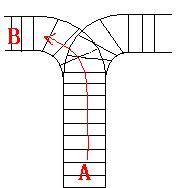hdu 1022 Train Problem I 棧
阿新 • • 發佈:2019-01-02
Train Problem I
Time Limit: 2000/1000 MS (Java/Others) Memory Limit: 65536/32768 K (Java/Others)
Total Submission(s): 3121 Accepted Submission(s): 1148


 InputThe input contains several test cases. Each test case consists of an integer, the number of trains, and two strings, the order of the trains come in:O1, and the order of the trains leave:O2. The input is terminated by the end of file. More details in the Sample Input.
InputThe input contains several test cases. Each test case consists of an integer, the number of trains, and two strings, the order of the trains come in:O1, and the order of the trains leave:O2. The input is terminated by the end of file. More details in the Sample Input.OutputThe output contains a string "No." if you can't exchange O2 to O1, or you should output a line contains "Yes.", and then output your way in exchanging the order(you should output "in" for a train getting into the railway, and "out" for a train getting out of the railway). Print a line contains "FINISH" after each test case. More details in the Sample Output.
Sample Input
3 123 321 3 123 312
Yes. in in in out out out FINISH No. FINISHHintHint For the first Sample Input, we let train 1 get in, then train 2 and train 3. So now train 3 is at the top of the railway, so train 3 can leave first, then train 2 and train 1. In the second Sample input, we should let train 3 leave first, so we have to let train 1 get in, then train 2 and train 3. Now we can let train 3 leave. But after that we can't let train 1 leave before train 2, because train 2 is at the top of the railway at the moment. So we output "No.".
設進出兩個順序分別為order1和order2,如果此時棧為空或者當前的棧頂元素不等於order2[i],就讓order1[j]入棧,同時將"in"記錄入q佇列中。
else如果此時棧頂元素等於order2[i],就將此棧頂元素彈出(sk.pop()),並將"out"記錄入q佇列。
不斷進行上面上面兩個判斷,直到兩個陣列遍歷完,或者在中途中達不到目標順序,使程式停止。
上面程式碼較為簡略了,後來又寫了一次,下面程式碼比較清晰:
#include<iostream>
#include<string>
#include<vector>
#include"functional"
#include<memory.h>
#include<vector>
#include"numeric"
#include"algorithm"
using namespace std;
#define min(a,b)a>b?b:a
#define N 12
#define IN 0
#define OUT 1
char o1[N],o2[N];
int seq[N*2];
int idx;
int cal(int n)
{
int c1=0,c2=0;
vector<char> V;
//V.push_back(o1[c1++]);
while(c1<=n)
{
while(!V.empty()&&V.back()==o2[c2])
{
V.pop_back();
seq[idx++]=OUT;
c2++;
}
while((V.empty()||V.back()!=o2[c2])&&c1<=n)
{
V.push_back(o1[c1]);
seq[idx++]=IN;
c1++;
}
}
if(c2<n)
return false;
return true;
}
int main()
{
int n;
while(cin>>n)
{
idx=0;
cin>>o1>>o2;
if(cal(n))
{
cout<<"Yes."<<endl;
for(int i=0;i<n*2;i++)
if(seq[i]==IN)
cout<<"in"<<endl;
else
cout<<"out"<<endl;
}
else
cout<<"No."<<endl;
cout<<"FINISH"<<endl;
}
return 0;
}